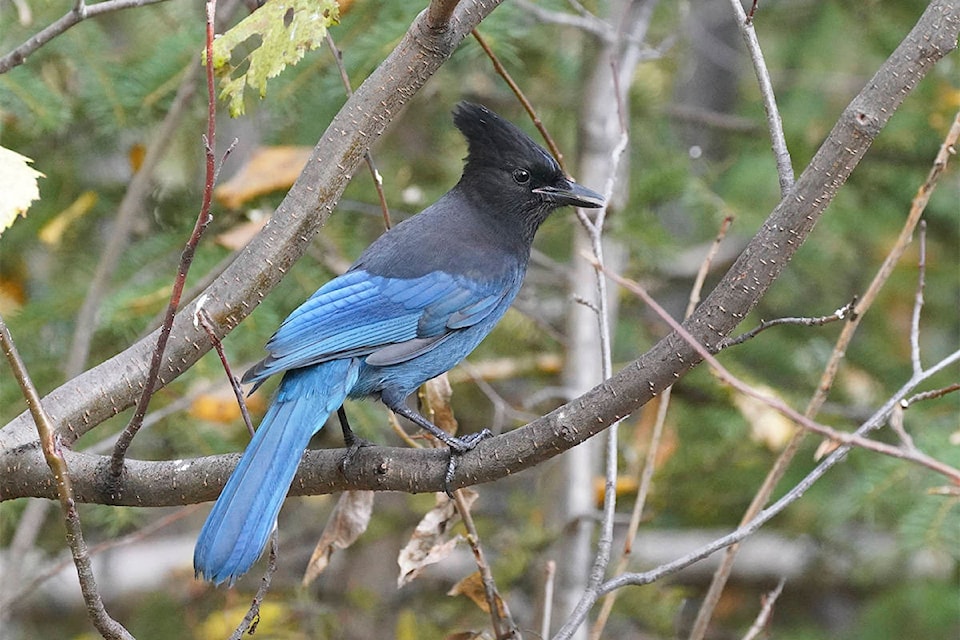The border with Alaska may be closed, but the pandemic isn’t stopping a cohort of colourful coastal jays from entertaining birders in Whitehorse and southern Yukon.
Local birders have noticed small groups of distinctive black-and-blue birds around town since September. The species is the Steller’s jay – a close relative of the eastern blue jay – who usually don’t venture this far northeast.
“Normally the species is incredibly rare in the territory, and hasn’t been found breeding here ever,” said Cameron Eckert, a director with the Yukon Bird Club.
The Steller’s jay is part of the Corvidae family that includes more common Yukon birds like crows, ravens, Canada jays and magpies.
The Western population of the species is generally similar in size to a magpie and has dark grey-black heads and bright blue lower halves, including tail feathers. They also have a distinctive spiky crest on the top of their heads.
The Steller’s jay is the provincial bird of British Columbia.
The normal range of the bird runs from areas of southern Mexico into southern Alaska, but in a normal year would completely bypass the Yukon, particularly an area as far from the coast as Whitehorse.
“The ‘why’ is an interesting question,” Eckert said. “Steller’s jays are known for movements, but not usually north like this. We can speculate but there isn’t a known factor as to why they would do this.”
The black-and-blue birds seen in Yukon this year have pink marks around their beaks, indicating they are juvenile birds in their first year out of the nest. It’s not known where their birthplace is, but the Yukon Bird Club has been tracking sightings that suggest they came up through Carcross.
A prevailing theory is that the young birds were blown towards the area by a windstorm event, but Eckert said he thinks that is unlikely.
A more likely situation is a “dispersal event” where the local population in an area had a sudden boom and the offspring travelled farther afield to access better food and territory.
“Now why they would disperse north and sort of east is really quite unknown. We can guess that there could be a lack of food wherever they were born. So they’re going from an area where there was not enough food to hopefully an area where there’s a bit more food.”
A wet summer and whether it influenced the success of breeding on the coast or the availability of food could also be a contributing factor,.
It isn’t the first time the species has showed up in record numbers, but it is unusual.
The Steller’s jay has visited in numbers twice before – in 2006 and 1994. Previous to that time, only nine sightings of the species had ever been reported in the Yukon.
“That’s one of the reasons we really encourage birders to take note of the special and the uncommon birds, but also to take special note of the common birds and the birds that are around you every day. Then you have a better chance of noticing when things are different. And when things are changing over time,” Eckert said.
Regardless of the reason for their visit, the arrival of the flamboyant blue-and-black birds has been a delight for local birders and photographers, who have been logging sightings from Teslin to Lake Laberge to Haines Junction and sharing photos online.
Eckert said the “invasion” likely involves hundreds of birds, but doesn’t extend much farther north than Whitehorse.
“The last time this happened in 2006. That was pre-Facebook and it was really pre-social media. There wasn’t this opportunity, this public expression of awe and enjoyment, at the arrival of these birds showing up in the yard,” Eckert said.
“So people are completely thrilled by this. They’re seeing something they’ve never seen before. And then also, it’s a Steller’s jay which is just a ridiculously beautiful bird,” he said.
Not only are the birds visually attention-getting, but they also exhibit interesting behaviour. Known as camp robbers and troublemakers in British Columbia, the birds are smart, bold and not too afraid to occasionally socialize with humans.
In addition to their usual shrieking call, they are also known to sometimes imitate predatory birds like hawks and osprey in order to scare other species away from a feeding area.
Eckert said the birds are likely to stay for the winter. Although not as well suited for the dry cold as the Canada jay, it is an omnivore that can adapt to different food and weather conditions.
“They’ve really honed in on peoples’ feeders. And also, they’re an opportunistic bird. So they can feed on just about anything,” Eckert said. “So I would expect them to be seen through the winter and into the following spring.”
“We’ll be enlisting feeder watchers to report their Steller’s jays and whatever else are coming to their feeders,” Eckert said.
Eckert said the annual Christmas Bird Count, which takes place in December each year and is open to the public, will be a good opportunity to track how many of the visitors are likely to secure sourdough status this year.
Contact Haley Ritchie at haley.ritchie@yukon-news.com
